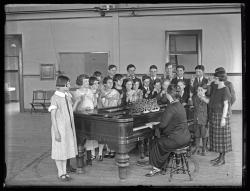The Body Politic is formed by a voluntary association of individuals. It is a social compact, by which the whole people covenants with each Citizen, and each Citizen with the whole people, that all shall be governed by certain Laws for the Common good. – John Adams (1779)
Be it enacted by the Senate and House of Representatives in Legislature assembled, as follows: … J.S. Wheelwright, Walter Brown, G. W. Merrill, A. W. Paine, …and their associates and successors are hereby incorporated by the name of the Home for Aged Women, for the purpose of providing a home for aged women in Bangor. – Fifty-First Legislature of the State of Maine, 1872

Music class, Maine School for the Deaf, Portland, 1925
Maine Historical Society/MaineToday Media
The question of where responsibility lies for meeting the educational, health, safety and general welfare needs of society have been and still are debated vigorously. Who is responsible and how needed care and services are delivered has changed as society's size, structures, and social institutions have changed.
In some ways, it seems that the question of care has come nearly full-circle. Persons with infirmities or disabilities once were cared for at home, or by the community as a whole. Then, institutions developed where those in need were housed or incarcerated. Then, institutions that had been developed as the most modern and most humane sites of care became outdated and their methods criticized. Improvements were made; new methods were adopted.
Still, many large-scale institutions were out of favor by the ending decades of the 20th century and those with infirmities or disabilities were reintegrated into communities or stayed at home to be cared for there, with various levels of support from the state or other agencies.

Women's Relief Corps, Garland, 1907
Garland Historical Society
From improvement associations like libraries, lyceums, working men's clubs, and women's improvement organizations, to municipal and state agencies and institutions, Maine, like other states, moved from traditional community cooperation and self-help to broadening the role of government and building schools for the deaf and blind, special institutes for the mentally ill, for those with tuberculosis or developmental disabilities, and prisons and reformatories to house the refractory.
Many of the results were a combination of private and public efforts, where boards of trustees incorporated as a school or asylum and the state subsidized indigent or specialized care. From about the 1830s on, Mainers supplied themselves with an array of institutions and associations to care for the aged, impoverished, ill, disabled, abandoned, and criminally minded among them, and to fit the rising generation for the future with advanced educational opportunities.

Lizzie Mae Jewell Potter Academy diploma, Sebago, 1899
Sebago Historical Society
In addition, educational institutions made the transition from private schools in people's homes, or tutors visiting children at home, to more formal schools and, eventually, town operated and state supervised institutions of learning.
Colleges and universities, too, developed, some public, some private, to serve larger student populations, to provide different types of education, and generally to meet the changing needs of students and the larger society.
Reforms in public education, incarceration and rehabilitation, public health, and welfare institutions and policies continued to develop across the nation during the 20th century. Governments expanded their roles, scientific management theories applied to many of the changes, and specialized practices and procedures increased dramatically.










